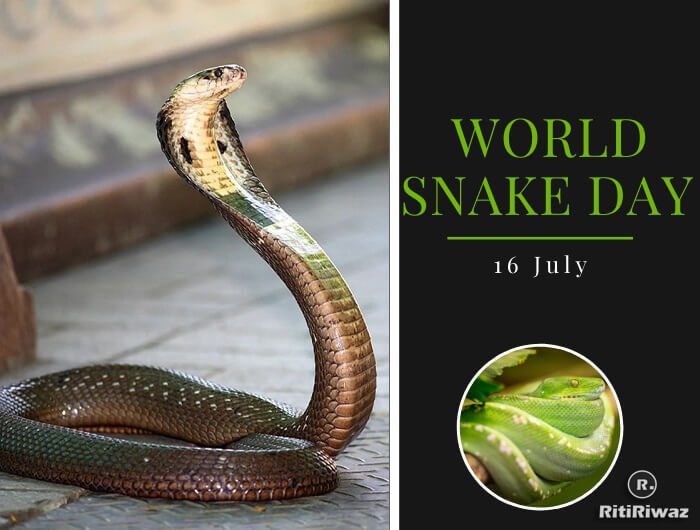World Snake Day – 16th July

World Snake Day is celebrated every year on July 16 to raise awareness of the more than 3,500 species found around the world and the important role they play in maintaining ecological balance.
To some snakes are scary, slithering creatures, while others see them as cool and fascinating pets. No matter where you may fall in your feelings toward these creatures, there is plenty we can learn about them. World Snake Day, thus, gives us all a global opportunity to join hands and contribute towards the conservation of snakes.
Snakes have inspired fear and fascination in the minds of people for ages. The origin of snakes is still heavily debated. Fossilized jawbones of early snakes have been found from the Mid-Jurassic around 167-143 million years ago (Caldwell et al., 2015). Some other studies suggest they originated later in the Early Cretaceous around 128.5 million years ago (Hsiang et al., 2015). According to the Reptile Database, there are more than 3700 snake species in the world (as of August 2019).
Indians believe in many myths, age-old superstitions about snakes; we associate snakes with supreme power, danger, and revenge. Many widespread panic stories of snake revenge and snake charmers we are told. Our ancestors, it is said, had seen pesky snakes dancing to the tunes of snake charmers; and snakes lapping up milk! It is sad that a good number of people even today believe in these superstitions and myths as these are firmly established in the popular consciousness.
Indians cling to the legend that one should crush the head of the snake after killing it. If this is not done, then the family of the snake will find the image of the person in the dead snake’s eyes and venture out to seek revenge. The word ‘Snake’ after sunset, is as good as inviting snakes over for dinner. If you play been (Indian wind instrument used by snake charmers) after sunset, it will attract snakes.
In India, snakes are worshipped during the holy month of Shravan. The Hindus worship the black cobra because it forms the garland around Lord Shiva’s neck. Snakes, especially King Cobras, are believed to be custodians of treasures. So, encountering snakes in forests may mean that there is treasure nearby. Snakes or cobras are also fed milk and it is prohibited to kill the snake in that month. The nagas are the serpent spirits that inhabit the underworld.
In Japan, there is an emphasis on the life-giving nature of the snake deity (from its symbolic molting) and the Japanese connect the snake with the agrarian worship of rice and the water god. In China, though, snakes and serpents symbolism means evil, cunning, and sycophancy. The Chinese believe that elves, fairies, and demons often transform themselves into snakes.
Interesting Facts About Snakes
-
Snakes are found on every continent except Antarctica.
-
Snakes can be found on land, in trees, and in the ocean.
-
Snakes are known for their ability to kill creatures bigger than them in size using venom.
-
Snakes shed their skin as they grow. They shed their skins approximately four to six times a year.
-
A snake has scales over his whole body, even in his eyes. Interestingly, they are made from the same material which makes up human nails, called Keratin.
-
Most snakes hatch from eggs. But some snakes give birth to live babies.
-
Snakes are cold-blooded reptiles that can externally control their body temperatures.
-
Snake skin looks shiny, so people often assume snakes feel slimy, but, in fact, their skin is smooth and dry to the touch.
-
Most snakes only come together to mate in the spring and early summer. Then the male and female immediately go their separate ways.
-
Snakes don’t have the right kind of teeth to chew, so they swallow their prey whole.
-
It kills its prey through venomous bite before eating. And in the case of a non-venomous snake, it constricts its prey until it’s dead.
-
Snake jawbones aren’t fused as ours are. A highly flexible ligament joins the bones of the lower jaw, which stretch to allow an enormous expansion of the mouth.
-
Snakes have weak eyesight. Its eyes are not its strongest sensor.
-
The tongue is the snake’s strongest sensor. It does have inner ears but it is its tongue that can sense the sound. So it will not be wrong if one says snakes hear through the tongue.
-
A snake’s tongue has a fork-like shape. The two ends are used for tasting and identifying different chemicals. A snake can identify the smell on its tongue.
-
Although they lack eardrums, snakes possess inner ears which are able to pick up not only ground-borne vibrations but low-frequency airborne sounds.
-
Primitive snakes such as pythons only have 1 lung.
-
A snakehead can bite you, even hours after the snake’s death. And be careful, this bite contains a lot of venoms.
-
The warmer a snake’s body is, the easier it is for him to digest its prey. The usual snakes take 3-5 days for digesting the prey but for large snakes like Anaconda, it can take weeks.
-
Snakes have a hibernation period. During winter snakes hibernate.
-
Snakes hunt at night time.
-
Snakes don’t need to eat food every day. In fact, some of the snakes can survive a year without food.
-
Most snakes are shy – not aggressive and only want to be left alone.
-
Ilha da Queimada Grande is Brazil’s snake island and is one of the world’s deadliest islands because it has the highest concentration of venomous snakes.
The beauty of living on Earth lies in living in harmony with animals – coexisting and letting them live. Snakes are just other creatures like many which own Earth equally. Only if disturbed, they cause us to harm in fear of their life. It is our responsibility to let them live their lives as they own Earth as much as we own.
Suggested Read: Important Days In July






